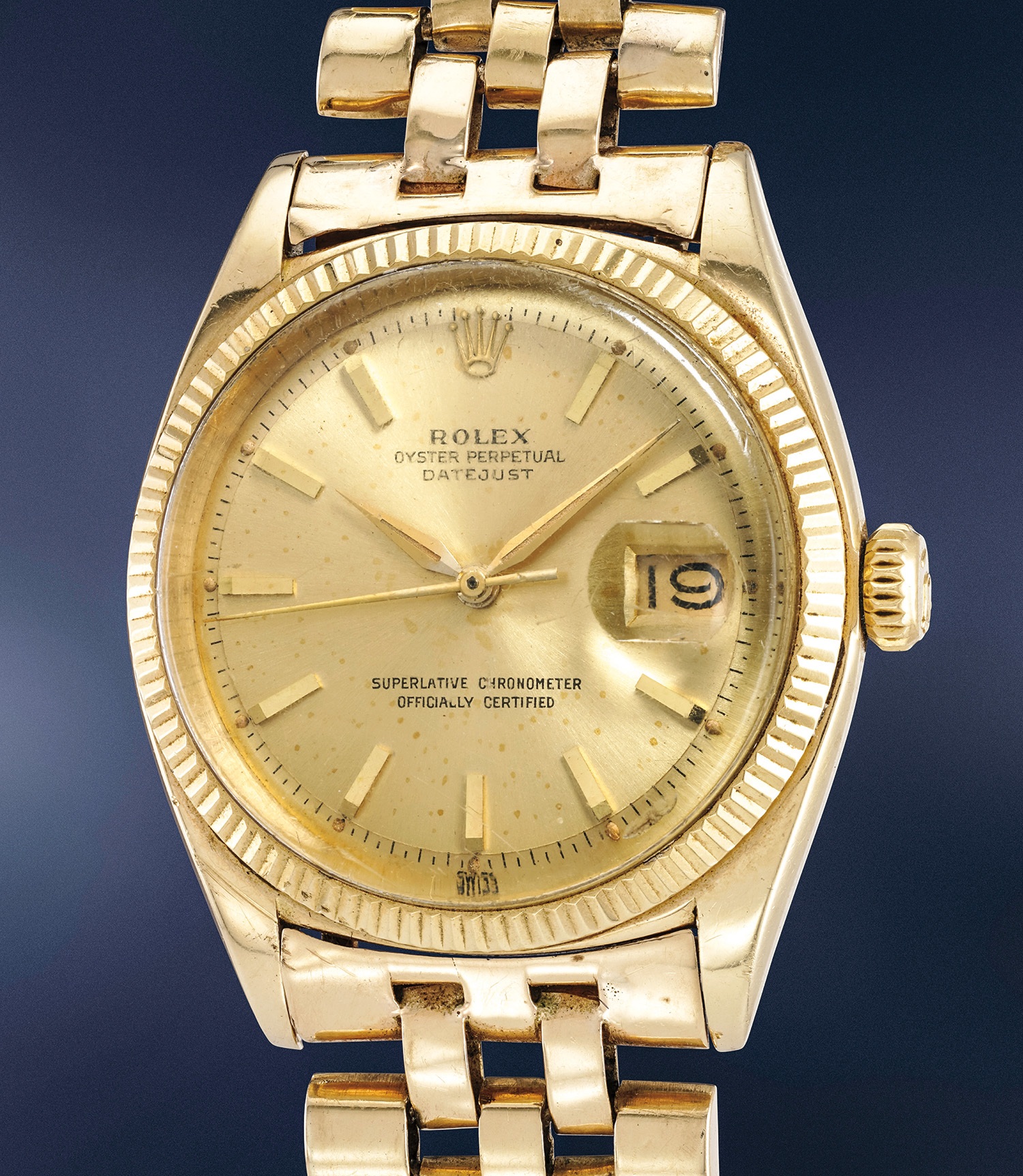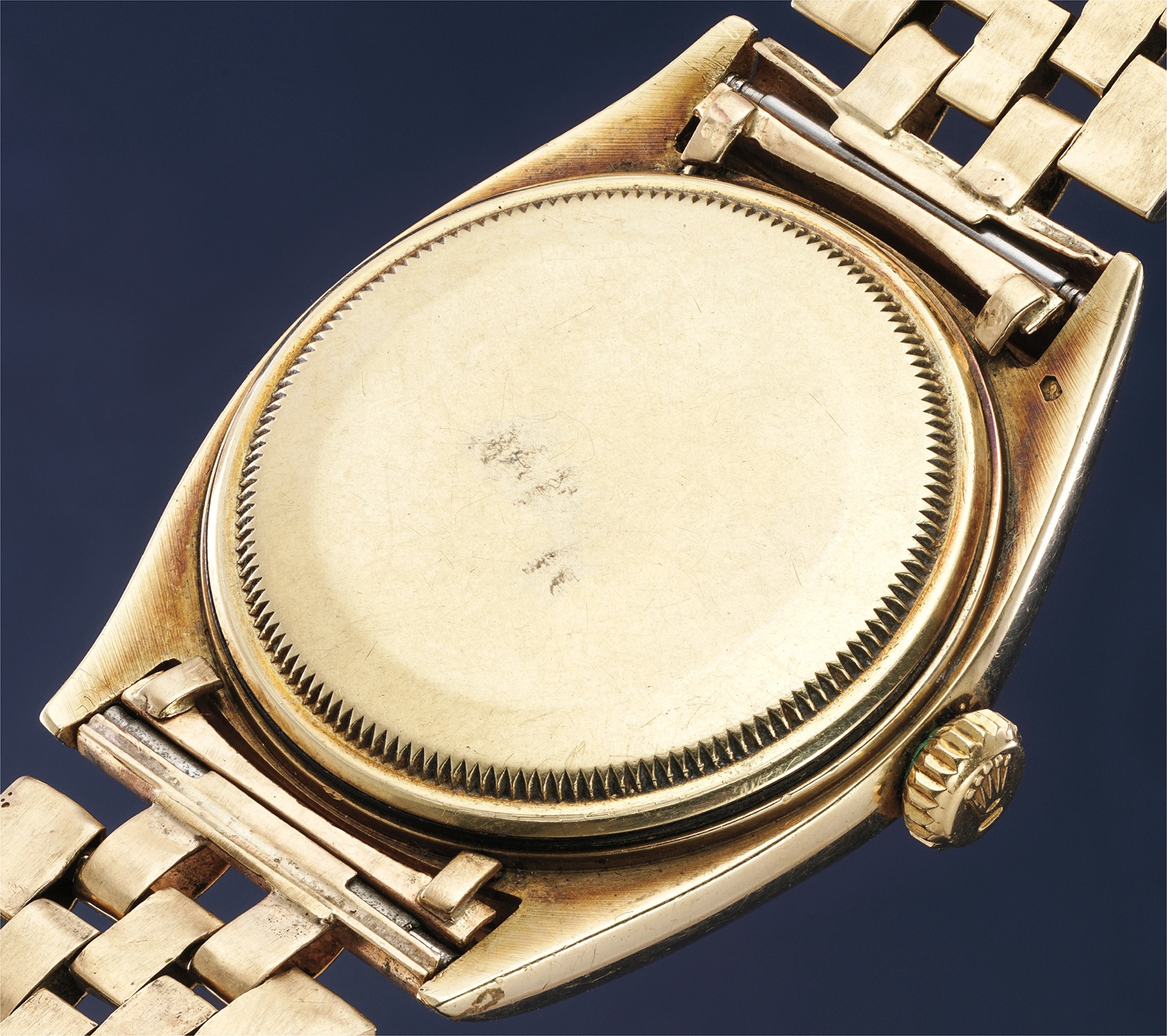













74
Rolex
Ref. 1601
Datejust
A historically important yellow gold wristwatch with date from estate of CIA agent Francis Gary Powers
Full-Cataloguing
The famous Rolex campaign, “Every Rolex Tells a Story”, couldn’t be more apropos when considering the history of the present watch’s original owner. An all-original Rolex Datejust reference 1601 in 14 karat gold, it was purchased by Francis Gary Powers in November 1962, the same year Powers and a detained American student were famously traded for the Soviet spy, Rudolf Abel. Consigned directly by Powers’ son, Francis Gary Powers, Jr., who cherished the watch following his father’s passing in 1977, it retains its original box, bracelet, guarantee, and chronometer rating certificate.
Exactly 60 years ago, on May 1st 1960, on the eve of a Paris Summit between U.S. President Dwight Eisenhower, Premier Nikita Khrushchev of the Soviet Union, Prime Minister Harold Macmillan of Great Britain, and President Charles de Gaulle of France, an American U2 spy plane was shot down over the Soviet Union by a Soviet surface-to-air missile.
The incident had its roots going back to a conference held in Geneva in 1955 between President Eisenhower and Premier Khrushchev, where due to the growing threat of nuclear weapons to each nations’ security, Eisenhower requested an “open skies” plan of permitting overflights of each other’s country to allow mutual aerial inspections of nuclear facilities and launch sites. Khrushchev refused while at the same time claiming the Soviet Union had successfully developed numerous intercontinental ballistic missiles.
Motivated to verify Khruschchev’s claims, the US developed the U2 spy plane program comprised of a high-altitude plane capable of flying above 70,000 feet. Its high-altitude capability was believed to make it undetectable to ground-based radar, as an overflight could be considered an act of war. Operated by the US Central Intelligence Agency (CIA), the U2’s first successful overflight would took place over Moscow in July 1956. Unbeknownst to the CIA, the Soviet’s were able to detect the U2 overflights on radar.
When the U2 plane piloted by Gary Powers was intercepted by the Soviet missile, a shockwave hit the plane, snapping off a wing and plunging it into an uncontrollable spin towards the earth. Powers thought to use the ejection seat, but realized his legs could be severed during the ejection unless he was precisely positioned. Instead, he simply opened the canopy and climbed out. As he released the canopy, he was immediately sucked up half-way out of the plane, stuck to the cockpit by his oxygen pump.
One of the most memorable scenes vividly recreated in Steven Spielberg’s 2015 film, “Bridge of Spies”, due to the g-forces of the rapidly descending plane and his position part way out of the plane, he could not reach the self-destruct mechanism on the plane’s dashboard to destroy the plane before it fell into Soviet hands. Finally freeing himself, he parachuted safely down to earth but was tracked by KGB agents and was arrested upon landing.
When confronted by the Soviets, the U.S.’s cover story held that Powers was studying weather patterns for NASA and merely strayed off course due to an oxygen failure The top-secret U2 spy plane was recovered by the Soviets and placed on public display in Moscow to illustrate America’s deceit.
Powers was put on trial for espionage and ultimately sentenced to three years in prison followed by seven years in a labor camp. He would remain in prison until his exchange on 10 February 1962, for Russian KGB spy Colonel Rudolf Abel who was held by the U.S. Prior to Powers’ return to the U.S., he was painted in a negative light prior to his release – criticized in the press for not destroying his plane or using a poison pin to take his own life.
During a U.S. Senate Committee hearing in 1962, he was given a chance to tell his side of the story in the public eye. Following their investigation, he was shown “to be a fine young man performing well under dangerous circumstances.” Documents declassified in 1998 showed he followed orders, gave out no secret information, and never denounced the U.S. while imprisoned. Fully exonerated, he was awarded $50,000 in back pay to cover his period of imprisonment in Russia – a significant sum in 1962!
With this windfall, Powers, who had an appreciation for quality objects, decided he would buy a fine watch. He visited the jeweler, Lane Crawford’s, in November of that year, and chose this classic gold ref. 1601 fitted on a 14-karat gold Jubilee-style bracelet stamped “Lane Crawford’s”. With its utterly fascinating CIA-agent provenance, this fresh-to-market, extraordinarily complete “Francis Gary Powers” Rolex Datejust, is a rare trophy watch for the connoisseur.
Rolex
Swiss | 1905Founded in 1905 England by Hans Wilsdorf and Alfred Davis as Wilsdorf & Davis, it soon became known as the Rolex Watch Company in 1915, moving its headquarters to Geneva in 1919. Like no other company, the success of the wristwatch can be attributed to many of Rolex's innovations that made them one of the most respected and well-known of all luxury brands. These innovations include their famous "Oyster" case — the world's first water resistant and dustproof watch case, invented in 1926 — and their "Perpetual" — the first reliable self-winding movement for wristwatches launched in 1933. They would form the foundation for Rolex's Datejust and Day-Date, respectively introduced in 1945 and 1956, but also importantly for their sports watches, such as the Explorer, Submariner and GMT-Master launched in the mid-1950s.
One of its most famous models is the Cosmograph Daytona. Launched in 1963, these chronographs are without any doubt amongst the most iconic and coveted of all collectible wristwatches. Other key collectible models include their most complicated vintage watches, including references 8171 and 6062 with triple calendar and moon phase, "Jean Claude Killy" triple date chronograph models and the Submariner, including early "big-crown" models and military-issued variants.